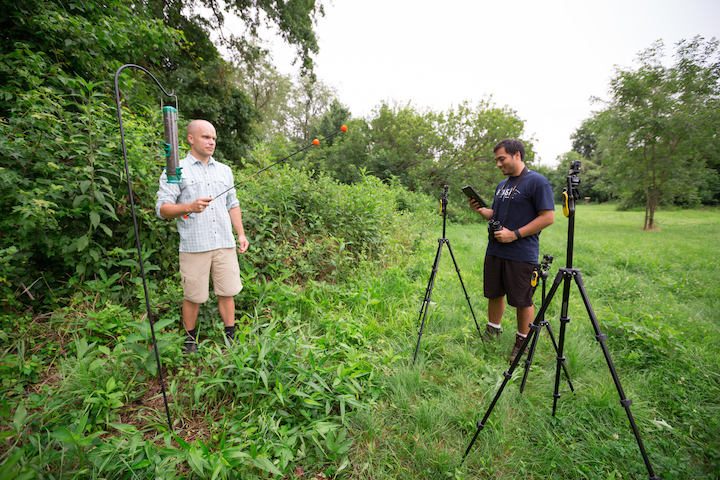Flight is the most energy-expensive form of locomotion, so wild birds usually conserve energy by flying at moderate speeds. To avoid predators when looking for their next meal, though, birds might trade energy efficiency for speed, but scientists aren’t sure.
Thanks to a Longwood research duo using the latest technology, the energetics of wild birds could become less of a mystery.
Alexon Munson-Catt ’16 and Dr. Brandon Jackson are videotaping, then analyzing, the flight paths and energy use of foraging wild birds with high-speed, high-resolution cameras that capture 3-D motion. The work, part of Longwood’s summer PRISM research program, focuses on the birds’ movement from dense shrubbery to feeders.
"We want to know how birds make behavioral decisions," said Jackson, assistant professor of biology, whose main academic interest is the evolution of animal locomotion, particularly bird flight. "We want to find out if wild birds adjust their flight speed to adjust their energetic costs and about how complex their decision making is."
Due to the limitations of technology, scientists have been unable to determine if—and how—wild birds change flight speed and patterns while foraging in the wild. Sophisticated but affordable cameras, combined with 3-D videography software developed by Jackson and some of his colleagues, should be able to provide answers.
"We want to know if birds will be flying fast to avoid predators, or at a more efficient speed even if it’s slower and thus places them at greater risk from predators," said Jackson. "We know that it costs a bird a lot to fly slow or fast; the minimum cost is flying at medium speed."
Munson-Catt and Jackson have set up three tripod-mounted GoPro HERO4 cameras in a field behind Lancer Park, where they’re recording birds moving from foliage to a feeder about six feet away. There is also a similar setup behind Jackson’s home in Charlottesville. After being downloaded on a computer in the comparative biomechanics lab in Chichester, the footage is analyzed for flight path and trajectory, velocity and acceleration, and wing-beat frequency.
"I’ve been recording at Lancer Park for four weeks, depending on the weather, but this morning was the first time I saw birds going from the foliage to the feeder," said Munson-Catt recently as he downloaded 12 recordings. "I saw cardinals and American goldfinches. The finches were on the feeder, the cardinals were on the ground getting the seed droppings. This morning was a mix of relief and excitement."
Jackson has had more bird activity at his home, where he has recorded not only cardinals and American goldfinches but also house finches and tufted titmouses. "I’m shocked that we haven’t had cardinals feeding at Lancer Park before now; they eat constantly," he said. "But the goldfinches are a good sign. They’re more aloof than cardinals, but they’re feeling comfortable with the new feeders. Our goal is to move the feeders farther away."
The cameras, operated by a handheld remote control, record the same action from different angles, filming at 240 frames per second. Though the tiny 64-gigabyte memory card in each camera can hold up to about 2-1/2 hours of footage, the researchers are filming in four-minute segments, which they have found yields the most workable files.
"GoPro cameras are becoming the way to track animals," said Jackson, adding that they’re also used by surfers and skiers, who attach them to helmets.
Munson-Catt, who is interested in the biomechanics of flight paths, has learned that flight patterns vary by species. "Some fly straight, some flap and glide," he said. "Some don’t like to fly out in the open; they like to stay in shrub areas. We’re trying to figure out their favorite flight pathways and their favorite trees so we can set up the cameras in the right pathway."
The biology major from Virginia Beach, who plans to attend medical school, said PRISM provides a rare opportunity for students working on bachelor’s degrees. "Most undergraduates don’t get to do this kind of research. Even though the waiting has been frustrating, I like the recording. The anticipation and seeing the results are exciting. Now I’m sure we’ll get better results. Once a bird sees another on a feeder, they go to it."
"Alexon is learning that science is not clear-cut," said Jackson. "It doesn’t always go as you plan; it often fails. Science is problem solving. Usually it’s the technology that is the problem but not in this case. The technology is working fine.
"Alexon came to me saying he wanted to do physiology research because I’m a physiologist, but he’s also learning ecology, ornithology, behavior, computer programming, physics and biomechanics. In the real world, you can’t focus on just one thing. You have to learn everything at once."



Leave a Comment